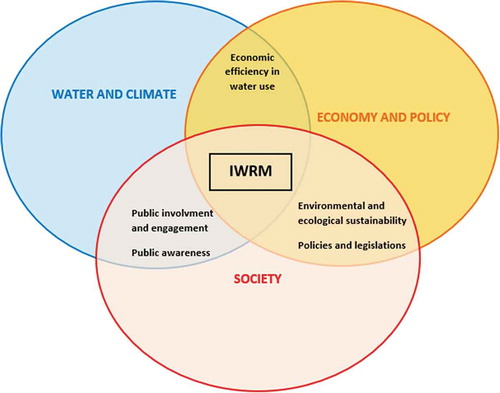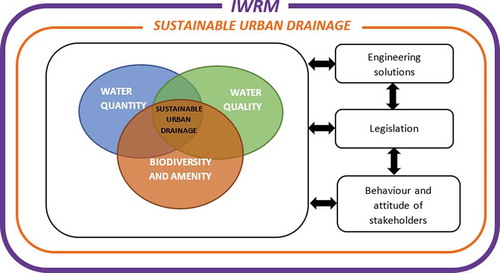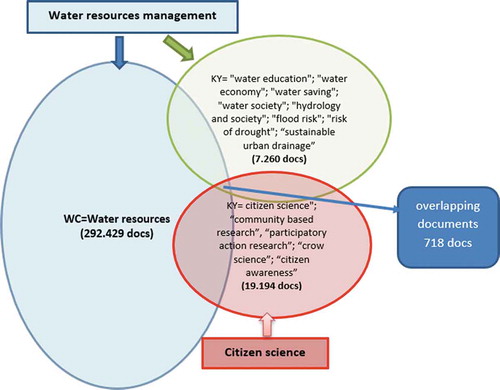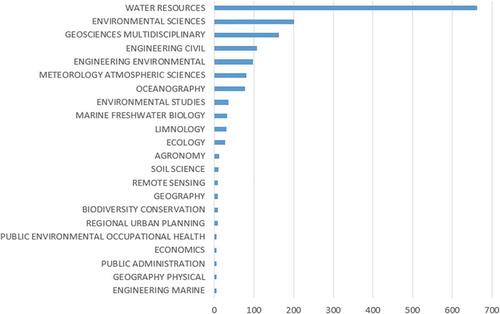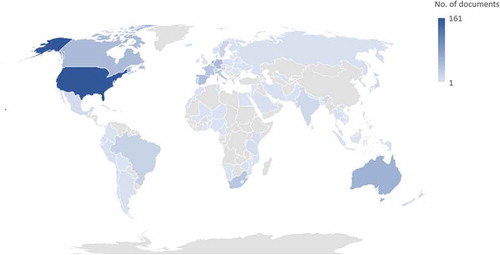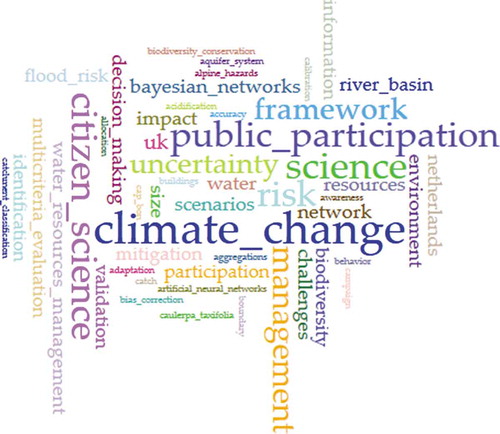 ?Mathematical formulae have been encoded as MathML and are displayed in this HTML version using MathJax in order to improve their display. Uncheck the box to turn MathJax off. This feature requires Javascript. Click on a formula to zoom.
?Mathematical formulae have been encoded as MathML and are displayed in this HTML version using MathJax in order to improve their display. Uncheck the box to turn MathJax off. This feature requires Javascript. Click on a formula to zoom.ABSTRACT
The main objective of this study is to detect scientific activities in the field of “water resources management” that include citizen science methods, using a bibliometric approach. The analysis aims at supporting the start of a new science shop based at the University of Brescia, Italy, in the framework of the European SciShops project. As the backdrop for science shops and community-based participatory research initiatives, citizen science is the focus of an increasing number of local, national and international activities, many of which are reported in the scientific literature available in the Web of Science. The results show that studies and publications on this topic, with a participatory perspective, are increasing. Australia, The Netherlands and Spain have a higher production than expected. The scarcity of Italian studies, especially on sustainable urban drainage, shows a promising field of work for future activities of the new science shop at Brescia.
Editor S. Archfield; Associate editor F. Nardi
Introduction
The importance of water resources management
Given the undoubted importance of water resources for life and most human activities, their management is fundamental to ensure sustainable development. In fact, its influence is evident in most crucial sectors: health, society, economy and environment. The main reasons why the management of water resources is needed are the following: (a) freshwater resources are limited and in many cases polluted, and are becoming more and more polluted in specific vulnerable areas of the world; (b) structures that control water (dams, dikes, etc.) may have undesirable consequences for the environment; (c) many citizens have no access to sufficient and safe freshwater; and (d) water is essential for crop production (WWAP Citation2018). Moreover, there is a strong relationship between the availability and distribution in time and space of groundwater, surface water, coastal water, freshwater, etc. (Savenije and Van der Zaag Citation2008).
Integrated water resources management
Since the consequences of proper or poor management of water resources may affect so many different and crucial sectors, integrated approaches have been suggested in the last few decades to find more robust and shared solutions. It is worth mentioning here the integrated water resources management (IWRM) first introduced at the United Nations Conference on Water held in Mar del Plata in 1977 (Rahaman and Varis Citation2005). This is a process that facilitates the co-ordinated development and management of water, land and their related resources, which has been further developed since then, especially at the beginning of the new millenium. The main aim of this process is to maximize economic and social welfare without compromising the sustainability of vital ecosystems. The word “integration” in the definition of IWRM is fundamental, and there are two categories of integration: the natural system and the human system. The first is connected to the availability and quality of water resources; it involves, for example, land, surface water and groundwater. The second is mainly connected to resource use; it involves, for example, a holistic institutional approach, the integration of water in the national economy and in the national policy development, the link between water resource planning and national security/trade policy, and the involvement of all stakeholders in the planning and decision process. Integration has to consider both natural and human systems (Jønch-Clausen and Fugl Citation2001).
The importance of IWRM has become evident thanks to the support of organizations such as the International Commission on Water Resources Systems (ICWRS) of the International Association of Hydrological Sciences (IAHS). The IAHS has been promoting IWRM in recent decades, mainly by promoting the research and development of water resources systems and the interconnection of their elements. The mutual dependence of sustainability and integration is the main principle for the planning activities of ICWRS. As various authors explain (e.g. Savenije and Van der Zaag Citation2008), the objective of ICWRS may be achieved in different ways: through the recognition of all the dimensions of water resources, integrating hydrological sciences, raising the profile of the human factor in hydrology and systematizing information.
The basic social, economic and environmental goals of IWRM are: (a) economic efficiency in water use, because of the scarcity of water as a resource and its finite and vulnerable nature; (b) social equity, because all people should have access to water; and (c) environmental and ecological sustainability, because the present use of water resources must not compromise their use by future generations. Four elements are required to implement IWRM and therefore to achieve its goals: an enabling environment (policies and legislations), appropriate institutional roles, practical management instruments (information, assessment and instruments) and public awareness. The last element is needed to create support for sustainable water management and induce the required changes in people’s behaviour and actions. Public awareness and the pressure for action may be very important in promoting the political willingness to act (Jønch-Clausen and Fugl Citation2001). Sustainable water resource systems have to satisfy changing demands without systems degradation; therefore, they have to contribute to the aims of society while maintaining its ecological, environmental and hydrological integrity, in the present and in the future (Loucks Citation2000).
However, public involvement (usually defined as actively involving people in research) and public engagement (usually defined as raising awareness of research) (Holmes et al. Citation2019) are important for any development initiative, including water-related projects; they are fundamental in IWRM to reduce conflicts and help projects to achieve their goals. Water use conflicts are especially noted in irrigation, hydropower production, farming activities and domestic uses. There are several ways to reach the public involvement, for example public hearing, notice and comment procedures and the use of advisory committees (Dungumaro and Madulu Citation2003).
There is another method of public involvement, which involves significant participation by citizens: community participation. This kind of participation in IWRM projects may yield the following benefits: (i) reduction of apathy and psychological suffering, because participants are aware that they are part of the total society and, therefore, they are responsible not only to themselves but to the society; (ii) empowering communities, because participants are not passive consumers of the services of others, but producers of those services; and (iii) dissemination of information, because participation in IWRM informs and educates participants and therefore they become able to cooperate and to defend their own interests (Chifamba Citation2013). presents a diagram of IWRM interactions.
In the field of research, in order to involve local people in IWRM it is necessary to overcome the conventional research approach and to start participatory research initiatives. Conventional research generates knowledge for the purpose of understanding, which may be independent of its use in acting, planning or implementation. The research is not for local people; rather, it is for institutional, personal or professional interest. Scientists, researchers and external agencies are involved as participants in research and planning; local people and their local priorities are not taken into consideration (Cornwall and Jewkes Citation1995). Starovoytova (Citation2017) states that the conventional research process consists of seven steps: formulate a research question/problem, make background observations, formulate a hypothesis, design the experiment, test the hypothesis/collect data, interpret/analyse the results, publish the findings. Cornwall and Jewkes (Citation1995) argue that participatory research generates knowledge with the aim of not only understanding, but also action. This research is carried out with and by local people and the topic choice is influenced by local priorities and perspective. Therefore, participatory research goes beyond the production of information, and it follows a “bottom-up” approach because local people are involved (Cornwall and Jewkes Citation1995). This research process is conducted with people; their life is the object of study and the political context must be adapted in order to permit that. For this reason, democracy is a precondition for participatory research, in order to allow the participation of different citizen groups and the social involvement of the researchers. Participatory research also requires a “safe space,” where the participants can trust each other, express critical or dissenting opinions, and feel free to express ideas or positions that will not be used against them (Bergold and Thomas Citation2012). The visibility and transparency of research are greater in participatory research than in conventional research (Cornwall and Jewkes Citation1995).
Participatory research initiatives: towards citizen science
The concept of participatory research has led to the concept of citizen science. This term was first used in the mid-1990s by a social scientist Alan Irwin in the UK, to underline the responsibility of science to society (Eitzel et al. Citation2017a, Citation2017b). The first dictionary to include the term “citizen science” was the Oxford English Dictionary, in 2014. It defines citizen science as “scientific work undertaken by members of the general public, often in collaboration with or under the direction of professional scientists and scientific institutions” (cited in Storksdieck et al. Citation2016).
At an institutional level, three major associations have been formed to ensure the development and management of citizen science and to support its growth and survival: the Citizen Science Association (CSAFootnote1 ), the European Citizen Science Association (ECSAFootnote2 ) and the Australian Citizen Science Association (ACSAFootnote3 ) (Bonney et al. Citation2016). These associations together represent a milestone in the development of citizen science as a field. Therefore, citizen science is a powerful bridge between scientific research and the larger society that can benefit from it; the three associations have to work together closely, to ensure that this bridge extends across the world. The aim is to share resources, to manage common issues and to facilitate co-learning (Storksdieck et al. Citation2016).
Citizen science: the backdrop for science shops
Citizen science can be considered the backdrop for a “science shop.” This new concept refers to a “unit that provides independent, participatory research support in response to concerns experienced by civil society” (Mulder and De Bok Citation2006). The word “science” here includes any field of knowledge, including for example social sciences, the humanities and engineering. Science shops use traditional science communication techniques, and they are part of an interactive science communication system.
Science shops often arise within a university and, therefore, they are based at that university, or they can be organized by an independent non-governmental organization (NGO). Questions from civil society organizations are the starting point for a scientific research project in a science shop. If the shop is based in a university, the research can be performed by students, under the supervision of a professor, or by a university researcher. Students usually get credit points and acquire new skills, for example problem definition, and project-based working, communication or planning. The professor or researcher gains useful material for future scientific publications or for further theoretical analysis. Therefore, science shops combine all three missions of the university (education, research and outreach), serving the non-profit sector. For these reasons, the science shop is often implemented in a university at relatively low cost.
The weaknesses of science shops are caused by fragility among actors, as defined by Mulder et al. (Citation2001): users (citizen, associations and enterprises), scientists (professors, researchers and students), institutions (universities or other supportive structure) and science shop staff (paid individuals who do mediation work). Indeed, “if only one of these actors is not able to participate, the science shop may fail” (Mulder and De Bok Citation2006).
The rise of a new science shop focused on sustainable urban drainage
Today, interest in science shops is not limited to the western world but has also spread to Asia and especially to India, China and Japan (see e.g. www.pria.org). The European Commission has expressed interest in initiatives that link science and society; therefore, many projects have been funded in recent years (e.g. ISSNET – Improving Science Shop Networking, INTERACTS – Improving Interaction between NGOs, Universities and Science Shops, SCIPAS – Study and Conference on Improving Public Access to Science through science shops and PERARES – Public Engagement with Research And Research Engagement with Society). Along these lines, the latest Horizon 2020 Programme includes the work programme “Science with and for Society,” under which the SciShops Project was funded by the European Commission. This European project involves 18 public and private organizations from different EU countries working together to create a new research method, based on a “bottom-up” approach, where private citizens and civil society organizations are actively involved in the research process. A survey conducted by this project revealed that the awareness of science shops among actors is relatively low and that the public is still poorly aware of their existence (De Filippo et al. Citation2018).
WatShop,Footnote4 the new science shop set up at the end of 2018 at the University of Brescia (Lombardy, northern Italy), was developed in this framework and started its activities at the beginning of 2019. This new science shop is one of the local outputs of the EU project SciShops, and it aims to support cooperation among civil society, public and private research centres and enterprises in the field of smart management of water resources in a changing climate. In WatShop, public involvement and public engagement are ensured through social networks (e.g. Twitter, Facebook, LinkedIn), a magazine on the website (containing news, events held and topics of interest), “infodays,” events and meetings in direct contact with civil society. The shop’s focus is on sustainable urban drainage (), accounting for climate and land-use change.
A conventional urban drainage system is a city infrastructure that collects and conveys both stormwater and wastewater away from urban areas, using sewer networks to ensure protection of water bodies through water treatment plants. The main goal is to manage the quantity of water, in order to avoid urban flooding in city areas. Therefore, the traditional urban drainage system neglects water quality issues. The sustainable urban drainage system considers other important aspects in urban water management, such as water quality, ecological protection, multiple water uses and recreational amenities (Woods Ballard et al. Citation2015). Some solutions in agreement with sustainable principles are local treatments, retention, re-use, infiltration and conveyance of water runoff in urban areas. In addition, environmental issues, such as limited capacities and flexibility of the conventional drainage system due to climate variability and urbanization, have to be considered. Climate change has a big impact on urban water systems because it changes urban runoff and urban flooding. Also, urbanization and land-cover modifications have to be considered, due to their influence on the quality and quantity of urban water in cities. Therefore, the sustainable drainage system should integrate water quantity, water quality, biodiversity and amenity aspects, and it needs to employ disciplines of engineering and sciences to ensure economic, social, ecological and environmental sustainability. The most popular techniques of sustainable drainage systems include filter and infiltration trenches, permeable surfaces, water storage, water harvesting, detention basins, wetlands and ponds (Zhou Citation2014).
Another important point is to influence the behaviour and attitude of stakeholders (for example through training and educational programmes, policies and laws) because they must be aware of the importance of the sustainable design in order to accept some facilities. Strategies for sustainable urban drainage system are needed at different decision levels (political, social, regional or local scale, for instance), but all of them require the dissemination of information and a clear understanding of the potentials and the main consequences of each decision. The participation of different stakeholders is important because a sustainable urban drainage system should be seen as an opportunity for development and improvement of social, educational and environmental conditions in urbanized areas. Law is also an important element, because the requirements of legislation define boundaries for engineering solutions and represent a driving force for research and applied solutions. The implementation of law reinforces the perception by society of the challenges of sustainable urban drainage systems, contributing to a higher level of participation and changes in the paradigms of institutions and politicians (Buytaert et al. Citation2014). Roy et al. (Citation2008) identified the lack of legislative mandate and the resistance to change as one of the main impediments to sustainable urban stormwater management in Australia and in the USA (Barbosa et al. Citation2012, Zhou Citation2014).
Study objectives and background
A bibliometric approach can be used to learn about scientific activity using citizen science/participatory science practices in areas related to water resources management. Bibliometrics, which assesses academic publications, has developed useful tools for analysing scientific activity at the macro level (countries, regions), meso level (subject areas, journals, institutions) and micro level (research groups or individual authors) (Vinkler Citation1988). It assesses the impact and visibility of different objects of study and has proven very effective in detecting new fronts of research (Callon et al. Citation1995). Based on these considerations, the main objectives of this study are as follows:
to detect, through an examination of scientific publications, IWRM activities that include a citizen science perspective;
to learn about the evolution of these activities over time and analyse their dynamics (countries and institutions involved, specialization in given topics, methodology used, etc.);
to analyse the specific case of sustainable urban drainage to identify previous activities, assess their operation and determine the main aspects to be considered when developing participatory initiatives on this topic; and
ultimately, to learn about previous studies in this field and to analyse other research done by Italian centres with the intention of setting up a science shop at the University of Brescia, Italy.
Previous studies have used bibliometric techniques to analyse the dynamics of different disciplines. Many analyses can be found that look into the evolution of productivity in areas such as sustainability or climate change, exploring the structure of the field in qualitative terms (Jerneck et al. Citation2011). The bibliometric approach has been applied to examine the development of sustainability science through the analysis of citations as well (Kajikawa et al. Citation2007, Citation2014, Buter and Van Raan Citation2013). The specific field of water resources also contains bibliometric studies, including Chuang et al. (Citation2011), which uses the Web of ScienceFootnote5 database to analyse the trends and characteristics of papers in this subject category. Other similar studies analyse related topics, such as river water quality assessment (Wang et al. Citation2016). According to Huai and Chai (Citation2016), a bibliometric study is very helpful for detecting new research areas, like water security, which is a fast-developing emerging topic. Other research analysing broader scientific fields has detected that the management of water resources is a subject of growing interest (Jappe Citation2007, Zhang et al. Citation2015, Zhuang et al. Citation2015, Liu et al. Citation2016, Ingwersen and Serrano-López Citation2018).
In the field of citizen science, several other research initiatives have been carried out using a bibliometric methodology. Comber et al. (Citation2014) describe a semantic analysis of terms used to describe citizen sensing and crowdsourced data used in scientific analyses. Follett and Strezov (Citation2015), in turn, used the Web of Science and Scopus®Footnote6 databases to detect and analyse publications on citizen science and their use in new research projects. Kullenberg and Kasperowski (Citation2016) developed a search strategy to monitor the changing use of terms related to Web of Science-listed publications about citizen science and projects culminating in scientific publications. Other recent papers describe case studies involving citizen participation, with analysis of the variations in output on the subject in Scopus (Onencan et al. Citation2018) and in Web of Science (Bautista-Puig et al. Citation2019).
Considering these previous studies, an ad hoc methodology was created for the analysis of publications on water resources management that include the citizen science perspective. The methodology is described in the following section.
Sources and methodology
The Web of Science (WoS) database was the source used for publication analysis. Despite its well-known linguistic and thematic biases (better coverage of publications in English and topics related to experimental and biomedical sciences) and the under-representation of publications from non-English-speaking countries (Bordons et al. Citation1996, Torres-Salinas et al. Citation2010), this source of information was chosen because it lists high-quality documents that can be analysed with content and visualization tools. The publications were retrieved from the Core Collection, which includes the Science Citation Index (SCI), Social Science Citation Index (SSCI) and Arts and Humanities Citation Index (A&HCI) databases.
To carry out the proposed analysis, the following steps were taken:
Step 1. Search strategy definition: The search procedure was divided into three strategies: identification of the IWRM field (Strategy 1), identification of publications about citizen science (Strategy 2) and identification of the overlap between the two, i.e. the area containing the publications that qualify for this study (Strategy 3). This three-step strategy enables the results to be validated more accurately. All documents were collected without temporal limitation until 2018.
Identification of WoS publications from the “Water Resources” category that have specific keywords in their title, abstract or keywords.
Strategy 1:
WC = “water resources” OR
TS = (“water education” OR “water economy” OR “water saving” OR “water society” OR “hydrology and society” OR “flood risk” OR “risk of drought” OR “sustainable urban drainage”)
Note: WoS category (WC) refers to Web of Science (WoS) category, and topic (TS) means the search in title, abstract and keywords.
Identification of publications on citizen science/participatory science, using a search strategy based on key terms. The strategy works by collecting terms previously identified as highly related to the topic under analysis (Kullenberg and Kasperowski Citation2016, Bautista-Puig et al. Citation2019). These terms were searched for in the title, abstract and keywords of the publications.
Strategy 2:
TS = (“citizen science” OR “citizen* scienc*” OR “communit* science*” OR “participator* research*” OR “participator* action* research*” OR “communit*-based research*” OR “citizen* research*” OR “science* shop*” OR “citizen* scient*” OR “Public-participation” OR “community engagement” OR “citizen awareness” OR “community perception” OR “community-based environmental change intervention” OR “community-based environment” OR “community-based environments” OR “community-based environmental protest” OR “community based environmental movements” OR “community-based environmental health” OR “community-based environmental education” OR “crowd* science” OR “civic technoscience” OR “community based auditing” OR “community environmental policing” OR “citizen observatories” OR “participatory science” OR “volunteer monitoring” OR “volunteered geographic information” OR “volun* GIS” OR “neogeography” OR “participatory GIS” OR “street science” OR “locally based monitoring” OR “volunteer based monitoring” OR “public participation in scientific research” OR “popular epidemiology” OR “public engagement” OR “participatory monitoring” OR “participatory sensing”)
Identification of publications in WoS’ “Water Resources” category that include a citizen science/participatory science perspective. The search field was not limited by publication date.
Step 2. Construction of a relational database: (in MySql) with the complete bibliographical information of each publication (title, authors, address, journal, citations, subject category, funding, etc.).
Step 3. Data processing and standardization: Debugging of information, standardization of some fields: date, name of institution, journal.
Step 4. Calculation of bibliometric indicators: These were identified by:
annual evolution of the number of documents: number and percentage of documents by year;
cumulative average growth rate (CAGR): average annual growth over the period:
where Yk and Yi are the values found for the first and last periods studied;
specialization by topic: classification of production based on how WoS assigns journals to topic categories (Web of Science Citation2019);
main countries involved: number of documents by country;
activity index: the percentage of contribution to the total WoS production for each country compared to its percentage of contribution to production on the target topic (Frame Citation1977); and
main productive institutions: number of documents by institution, using the WoS “Organizations – Enhanced List” tool.
Step 5. Analysis of document content through word frequency analysis: WoS Keyword Plus was selected (keywords generated by the database itself) (WoS 2019). After downloading all keywords, the data were standardized to reduce redundancies and to group similar terms (word families, gender and number adjustments, etc.). A term frequency analysis using both simple (single-word) and compound terms was carried out to identify the main concepts mentioned in the publications.
Step 6. Data visualization: To visualize the relationships between keywords, the VOSviewer program (Van Eck and Waltman Citation2009) was used to cluster information into document groups with similar characteristics.
Results
The main results of the publication analysis are summarized in .
Bibliometric indicators
Seven hundred and eighteen publications were compiled from the field of Water Resources that included aspects related to citizen science/participatory science. The oldest document dates from 1980 and is entitled “Identification of training needs for public-participation responsibilities.” It is by an author from the Water Resources Research Center at the University of Massachusetts and was published in Water Resources Bulletin. The early date of that paper notwithstanding, it is only in recent years that the bulk of the documents on water resources have been published (slightly more than 50% were published in the last 6 years). Although there are production peaks, the annual growth rate is 10.6%. shows the annual growth of publications as well as the trend-based estimated increase in the coming years.
Figure 4. Annual development of publication (no. of documents). The dotted red line corresponds to the annual growth rate (1980–2018)
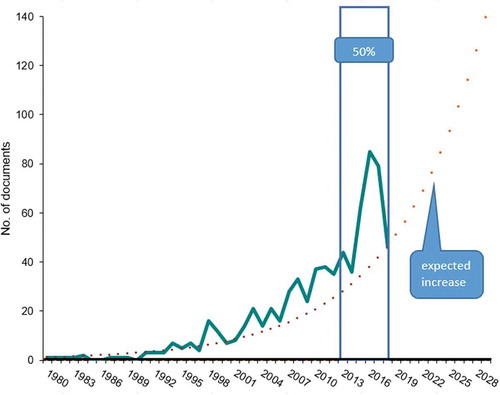
Ninety-two percent of the collected publications are included in the “water resources” category of WoS, but the multi-assignment of the publication journals shows that another 50 disciplines are present, such as environmental sciences (28%) and geoscience (23%). shows the main categories of the publications.
Eighty-six countries were found to have publications on water resources, led by the following: USA (23%), UK (14%), The Netherlands (11%) and Australia (8%). shows the publication distribution by country. Since a country’s size directly influences its production volume, the activity index of each country was calculated to ascertain that country’s relative specialization in this particular research field. The results show that, among the countries with the highest production, the USA has a low specialization in this subject, while The Netherlands, Australia and Spain exhibit a higher proportion than might be expected considering their total production volume. The most productive institutions are the IHE Delft Institute for Water Education, Delft University of Technology and Wageningen University Research, all in The Netherlands ().
Table 1. Distribution of publications by institution
Papers on water resources management were published in 229 journals. The main journals are Ocean Coastal Management (9%), Journal of the American Water Resources Association (5%), Natural Hazards (4%) and Water Science and Technology (4%). The Journal of Hydrology published 11 papers on this topic. Of all the documents retrieved (719), 145 (20%) are in open-access journals.
Content analysis
Keyword co-occurrence
The most frequent keywords in the retrieved documents are shown in . For the purposes of this research, all the keywords of the documents were selected and, after standardization, they were counted. Simple terms and compound terms were included. As shown in , the most commonly used words were “management” (as a simple term associated with the management of the environment and water resources), “public participation” and “governance.”
Table 2. Frequently used keywords (>10 documents)
To analyse the relationships between terms, three thematic clusters were identified. The clusters are represented by different colours in , denoting the relationships between the keywords. The volume of each node indicates its frequency of appearance in the documents (greater size = greater frequency of appearance) and the edges are the relationships (two documents are shown linked when they appear together in the documents).
The red cluster includes terms such as “management” (the most frequent term) related to other specific terms such as “sustainability,” “ecosystem” and “conservation.” Within the subject of water resources, the associated term most commonly used is “sea.” “Australia” is a leading keyword, which indicates that a significant number of documents refer to case studies carried out in Australia. Although this cluster does not show typical expressions of studies on citizen science, there are terms closely related to “citizen science,” such as “participation,” “stakeholders” and “co-management.”
The green cluster, on the other hand, shows the keyword “public-participation” as the most outstanding node; it has relations with other keywords such as “citizen participation” and “consensus.” This reveals references to papers that mention the application of participatory research techniques. They seem to be studies related to “hydrology,” “environment” and “climate.” Here, the most frequent case studies refer to geographical locations such as Europe, the UK or Germany.
The blue cluster is organized around keywords such as “climate change,” which is the axis of documents analysing the “perception,” “impact,” “information,” “risks,” etc., of climate change. Here, the UK appears as a geographical place of reference, and “water” features as a specific term for the issue of water resources ().
Contextualizing the University of Brescia science shop: previous water resources management studies in Italy
Thirty-three publications by Italian authors were identified out of all the documents analysed. These documents were published in 2008 or later and show a high concentration in recent years. Thirty-five signatory institutions were identified, mostly universities, although centres belonging to the Consiglio Nazionale della Ricerca also appear. shows the main characteristics of the texts. The geographical distribution of the papers shows that cities such as Venice and Bologna stand in the forefront, with six documents each (). Moving on to the content of the papers, the most frequent terms were “climate change” (five documents); “citizen science” (four documents) and “public participation” (four documents, see ).
Table 3. Characteristics of Italian publications on water resources management. OA: open access
Figure 8. Geographical distribution of papers by authors affiliated with Italian centres (1980–2018)
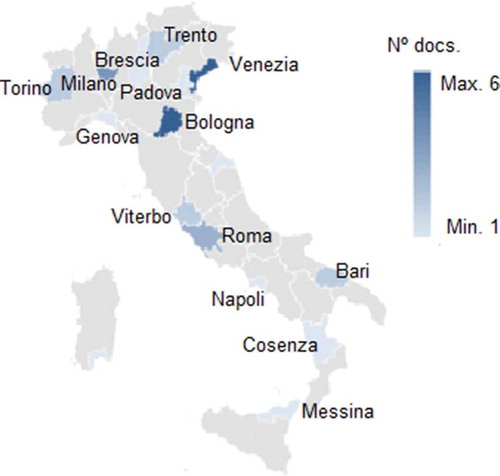
Some of the texts by authors from Italian centres refer to case studies conducted in countries in Africa, Europe and India that have adopted participatory decision-making processes for water resources management. Other papers are methodological and analyse the advantages, limitations and challenges of incorporating citizen science approaches to deal with issues such as drought, floods and resources management. The papers that refer specifically to Italy analyse methods for water management in geographical regions, such as the Alpine sub-basin in northern Italy, the Candelario Basin, the Po River Basin and areas such as Sardinia, the Mediterranean coast or the Alpine region.
Among these texts, one from the University of Brescia (Milanesi et al. Citation2016) was identified that proposes a citizen science-based approach for analysing and studying flood risk based on information provided by citizens.
Focusing on participatory research on sustainable urban drainage
Since the WatShop in Brescia focuses on sustainable urban drainage, the WoS database was consulted for the background of this particular topic, and publications were identified whose title, abstract or keywords mention terms associated with “sustainable urban drainage.” One hundred and ninety-four documents published since 1993 were detected, concentrated primarily in the last 5 years. England (UK) is the main signatory country, followed by Scotland (UK). The University of Edinburgh (Scotland) is the largest institutional producer. Two documents were identified that include terms related to citizen science. shows the main characteristics of these documents.
Table 4. Characteristics of Italian publications on sustainable urban drainage. OA: open access
As for the content of the papers, the first study (Marsalek and Chocat Citation2002) presents the results of an international project with the participation of 18 countries to survey urban stormwater management. The main findings point to growing interest in the subject and acceptance of a holistic approach to the sustainable management of urban drainage systems. This implies a transition to a green model and the formation of agencies involving different public and private actors in the stages of planning, implementing and operating water management systems. This publication highlights the interest in and necessity of adopting participatory methodologies involving different stakeholders.
The most recent paper (Jiusto and Kenney Citation2016) focuses on urban drainage in informal settlement areas in developing countries. The perspective it takes is different to that of Marsalek and Chocat, because this paper presents the case of several South African projects implementing a participatory methodology. The article shows how solutions have been found to drainage problems in informal settlements through the collaborative efforts of a number of social actors.
Discussion and conclusions
Analysis of previous research work studying citizen science from a scientometric perspective shows that from 2010 on, there is a notable increase in publications (Bonney et al. Citation2009, Comber et al. Citation2014, Follett and Strezov Citation2015, Kullenberg and Kasperowski Citation2016).
The increase of production on the subject of citizen science is partly due to the implementation of large-scale programmes such as the European Union’s framework programmes, which have served to reflect on the scope and limitations of participatory research. The latest H2020 Programme included several calls focusing on these issues, as exemplified by the Science with and for Society work programme. As the results of different investigations show, open science and citizen science initiatives in disciplines as diverse as health (Belansky et al. Citation2011), the environment (Conrad and Hilchey Citation2011), astronomy (Raddick et al. Citation2013) and social sciences (Wright et al. Citation2017) have shown the benefits of practices in which science extends beyond open access, reaching out to social actors and feeding back into the production of new knowledge. Another recent study has also detected an important concentration of papers on citizen science in areas such as the environment and geography (Bautista-Puig et al. Citation2019). One possible explanation for the recent increase in production is that since 2012 the European Union has financed five projects on the subject of “Development of community-based environmental monitoring and information systems using innovative and novel Earth observation applications,” and their results have become available in recent years.
In the specific case of science shops, initiatives have been detected that promote the development of science shops and sow the seeds for reflection on their implementation. European Union framework programmes have included pro-jects dealing with science shops. The first, SCIPAS, was awarded in 2000 under Framework Programme 5 (FP5) (De Filippo et al. Citation2018). The last of the projects financed so far has been SciShops.eu, under which the present research was done.
The results of this work show that research on water resources management from a participatory perspective has also gained increasing interest, and that recent years have seen an increase in publications on the subject. Although water resources management is a specific subject, it is also a crosscutting topic that intersects with various fields of knowledge and is therefore related to publications on the environment and geosciences. While the high-production countries like the USA are also the leaders in terms of sheer numbers of publications on this particular subject, other countries, such as Australia, The Netherlands and Spain, whose production is higher than expected (considering their activity index), stand out due to the intensity of their research. At the institutional level it is the universities (especially those in The Netherlands) and the research centres that lead research in water resources management. This fact is also related to the highly active participation of institutions in The Netherlands in European science shop projects, both as project leaders and as partners (De Filippo et al. Citation2018).
The journals publishing papers on water resources management are quite diverse, but almost 25% of the published papers were printed by the first four titles discussed: Ocean Coast Management, Journal of the American Water Resources Association, Natural Hazards and Water Science and Technology.
Content investigation reveals that terms such as “climate change” and “river basin” associated with actions such as “conservation” or “management” stand high on the list of subjects. From the perspective of city science, “public participation” appears as one of the most frequent keywords, and “citizen science” has a large number of mentions.
Analysis of the research set in Italy points to recent interest in projects and publications related to water resources management from a perspective that includes citizen participation. Previous studies on sustainable urban drainage in the region of Lombardy are few; thus, the WatShop has a promising field of work before it.
The work done in Italy is bound to become more and more meaningful as time goes on, because Italian authorities are increasingly using the participatory approach in the process of planning water districts, as called for by European directives (2000/60/EC, 2007/60/EC). In addition, many interdisciplinary activities encouraged by the European Commission or by international associations dealing with water science and society, such as the IAHS, are spreading, and they involve an increasing number of Italian case studies. One of the most recent interdisciplinary events was the Citizen Observatory for Natural Hazards and Water Management (https://www.cowm.eu/), which was held in November 2018 in Venice and gathered actors interested in citizen science dealing with natural hazards and water management. Many experiences were reported there, and many other such events are being planned for the future.
Urban drainage, as a sub-group of integrated water services, is becoming more and more challenging because of the increasing effects of climate and land-use change. Water service providers, urban planners, citizens and researchers need to cooperate to find shared sustainable solutions and make cities more resilient. The need for cooperation is increased by specific regulations, such as the recent regulation approved by the Lombardy Region in 2017 ensuring hydraulic and hydrological invariance for new urban areas. Since this regulation came into force, discussion has arisen among technicians, local authorities and researchers, supporting an update of the regulation (published in 2019). In this context, the University of Brescia’s WatShop promotes educational and participatory research activities on this specific focus and might play a fundamental role in future discussion involving local communities.
Regarding the limitations of the work, two clarifications are in order. First, any search strategy for analysing publications on a given topic is subjective. This study has used terms chosen to construct an object of study that approaches the field of IWRM and citizen science as closely as possible. For this purpose, previous delimitations of the source of information itself and other delimitations drawn from the specific literature on the subject have been used and have proved sufficiently solid for the exploration of both topics (IWRM and citizen science).
Second, citizen science contains numerous “invisible” practices that cannot be captured through a quantitative analysis of scientific production. Such practices include new citizen science projects at institutional, regional and national levels, dissemination and transfer activities, co-creation events, training activities and a large number of actions that fall outside the scope of this study.
Undoubtedly, the implementation of WatShop at the University of Brescia will enable all these actions to be followed up directly and, as a result, a more in-depth understanding can be gained of the impact they may have, not only on the academic field but also in the social realm.
Acknowledgements
This study received funding from the European Union’s Horizon 2020 Research and Innovation Programme [Grant 741657], under the name SciShops.eu. The content of this article does not reflect the official opinion of the European Union. Responsibility for the information and views expressed in the article lies entirely with the authors.
Disclosure statement
No potential conflict of interest was reported by the authors.
Additional information
Funding
Notes
5 Clarivate Analytics (Citation2020).
6 Elsevier (Citation2020).
References
- Barbosa, A.E., Fernandes, J.N., and David, L.M., 2012. Key issues for sustainable urban stormwater management. Water Research, 46, 6787–6798. doi:10.1016/j.watres.2012.05.029
- Bautista-Puig, N., et al., 2019. Scientific landscape of citizen science publications: dynamics, content and presence in social media. Publications, 7 (1), 12. doi:10.3390/publications7010012
- Belansky, E.S., et al., 2011. An adapted version of intervention mapping (AIM) is a tool for conducting community-based participatory research. Health Promotion Practice, 12, 440–455. doi:10.1177/1524839909334620
- Bergold, J. and Thomas, S., 2012. Participatory research methods: a methodological approach in motion [110 paragraphs]. Forum Qualitative Sozialforschung/Forum: Qualitative Social Research, 13 (1), Art, 30. Available from: http://nbn-resolving.de/urn:nbn:de:0114-fqs1201302
- Bonney, R., et al., 2009. Citizen science: a developing tool for expanding science knowledge and scientific literacy. BioScience, 59, 977–984.
- Bonney, R., Cooper, C., and Ballard, H., 2016. The theory and practice of citizen science: launching a new journal. Citizen and Science: Theory and Practice, 1 (1), 1, 1–4. doi:10.5334/cstp.65
- Bordons, M., et al., 1996. Local, domestic and international scientific collaboration in biomedical research. Scientometrics, 37, 279–295. doi:10.1007/BF02093625
- Buter, R.K. and Van Raan, A.F.J., 2013. Identification and analysis of the highly cited knowledge base of sustainability science. Sustainability Science, 8 (2), 253–267.
- Buytaert, W., et al., 2014. Citizen science in hydrology and water resources: opportunities for knowledge generation, ecosystem service management, and sustainable development. Frontiers in Earth Science, 2, 26.
- Callon, M., Courtial, J.P., and Penan, H., 1995. Cienciometría: laMediciónde laActividadCientífica: delaBibliometríaa la Vigilancia Tecnológica. Gijón, Spain: Trea.
- Chifamba, E., 2013. Community participation in integrated water resources management in the Save catchment, Zimbabwe. Journal of Environmental Science and Water Resources, 2 (10), 360–374.
- Chuang, K.Y., Huang, M.H., and Ho, Y.S., 2011. High-impact papers presented in the subject category of water resources in the Essential Science Indicators database of the Institute for Scientific Information. Scientometrics, 87 (3), 551–562. doi:10.1007/s11192-011-0365-2
- Clarivate Analytics. 2020. Web of Science database. Available from: http://www.webofknowledge.com
- Comber, A., et al., 2014. Semantic analysis of citizen sensing, crowdsourcing and VGI. Association of Geographic Information Laboratories for Europe (AGILE). Available from: http://publications.jrc.ec.europa.eu/repository/handle/111111111/32030 [Accessed 15 October 2018].
- Conrad, C.C. and Hilchey, K.G., 2011. A review of citizen science and community-based environmental monitoring: issues and opportunities. Environmental Monitoring and Assessment, 176, 273–291. doi:10.1007/s10661-010-1582-5
- Cornwall, A. and Jewkes, R., 1995. What is participatory research? Social Science & Medicine, 41 (12), 1667–1676. doi:10.1016/0277-9536(95)00127-S
- De Filippo, D., et al., 2018. A bridge between society and universities: a documentary analysis of science shops. Publications, 6, 0036. (incluida en WoS). doi:10.3390/publications6030036
- Dungumaro, E.W. and Madulu, N.F., 2003. Public participation in integrated water resources management: the case of Tanzania. Physics and Chemistry of the Earth, 28, 1009–1014. doi:10.1016/j.pce.2003.08.042
- Eitzel, M.V., et al., 2017a. Citizen science terminology matters: exploring key terms. Citizen Science: Theory and Practice, 2 (1), 1, 1–20. doi:10.5334/cstp.96
- Eitzel, M.V., et al., 2017b. Correction: citizen science terminology matters: exploring key terms. Citizen Science: Theory and Practice, 2 (1), 2, 1–3. doi:10.5334/cstp.113
- Elsevier. 2020. Scopus database. Available from: http:www.scopus.com
- Follett, R. and Strezov, V., 2015. An analysis of citizen science based research: usage and publication patterns. PLoS One, 10, e0143687. doi:10.1371/journal.pone.0143687
- Frame, J.D., 1977. Mainstream research in Latin America and the Caribbean. Interciencia, 2 (3), 143–148.
- Holmes, L., et al., 2019. Innovating public engagement and patient involvement through strategic collaboration and practice. Research Involvement and Engagement, 5, Art. 30. doi:10.1186/s40900-019-0160-4
- Huai, C.Q. and Chai, L.H., 2016. A bibliometric analysis on the performance and underlying dynamic patterns of water security research. Scientometrics, 108 (3), 1531–1551. doi:10.1007/s11192-016-2019-x
- Ingwersen, P. and Serrano-López, A.E., 2018. Smart city research 1990–2016. Scientometrics, 117 (2), 1205–1236. doi:10.1007/s11192-018-2901-9
- Jappe, A., 2007. Explaining international collaboration in global environmental change research. Scientometrics, 71 (3), 367–390. doi:10.1007/s11192-007-1676-1
- Jerneck, A., et al., 2011. Structuring sustainability science. Sustainability Science, 6 (1), 69–82. doi:10.1007/s11625-010-0117-x
- Jiusto, S. and Kenney, M., 2016. Hard rain gonna fall: strategies for sustainable urban drainage in informal settlements. Urban Water Journal, 13 (3), 253–269. doi:10.1080/1573062X.2014.991329
- Jønch-Clausen, T. and Fugl, J., 2001. Firming up the conceptual basis of integrated water resources management. International Journal of Water Resources Development, 17 (4), 501–510. doi:10.1080/07900620120094055
- Kajikawa, Y., et al., 2007. Creating an academic landscape of sustainability science: an analysis of the citation network. Sustainability Science, 2 (2), 221–231. doi:10.1007/s11625-007-0027-8
- Kajikawa, Y., Tacoa, F., and Yamaguchi, K., 2014. Sustainability Science: the changing landscape of sustainability research. Sustainability Science, 9, 431–438. doi:10.1007/s11625-014-0244-x
- Kullenberg, C. and Kasperowski, D., 2016. What is citizen science?—A scientometric meta-analysis. PLoSONE, 11, e0147152. doi:10.1371/journal.pone.0147152
- Liu, F.L., et al., 2016. Global research trends of geographical information system from 1961 to 2010: a bibliometric analysis. Scientometrics, 106 (2), 751–768. doi:10.1007/s11192-015-1789-x
- Loucks, D.P., 2000. Sustainable water resources management. Water International, 25 (1), 3–10. doi:10.1080/02508060008686793
- Marsalek and Chocat, 2002. International report: stormwater management. Water Science and Technology, 46, 1–17. doi:10.2166/wst.2002.0657
- Milanesi, L., Pilotti, M., and Bacchi, B., 2016. Using web-based observations to identify thresholds of a person’s stability in a Flow. Water Resources Research, 52 (10), 7793–7805. doi:10.1002/2016WR019182
- Mulder, H.A.J., et al., 2001. Success and failure in starting science shops. SCIPAS Report N.2. Utrecht, The Netherlands: Utrecht University.
- Mulder, H.A.J. and De Bok, C.F.M., 2006. Science shops as university-community interfaces: an interactive approach in science communication. In: D. Cheng, J. Metcalfe, and B. Schiele, eds. At the human scale - international practices in science communication. Beijing, China: Science Press.
- Onencan, A.M., Meesters, K., and Van de Walle, B., 2018. Methodology for participatory GIS risk mapping and citizen science for Solotvyno Salt Mines. Remote Sensing, 10, 1828. doi:10.3390/rs10111828
- Raddick, M.J., et al., 2013. Galaxy Zoo: motivations of citizen scientists. arXiv, 1303.6886.
- Rahaman, M.M. and Varis, O., 2005. Integrated water resources management: evolution, prospects and futura challenges. Sustainability: Science, Practice and Policy, 1 (1), 15–21. doi:10.1080/15487733.2005.11907961
- Roy, A.H., et al., 2008. Impediments and solutions to sustainable, watershed-scale urban stormwater management: lessons from Australia and the United States. Environmental Management, 42, 344–359. doi:10.1007/s00267-008-9119-1
- Savenije, H.H.G. and Van der Zaag, P., 2008. Integrated water resources management: concepts and issues. Physics and Chemistry of the Earth, 33, 290–297. doi:10.1016/j.pce.2008.02.003
- Starovoytova, D., 2017. Scientific research, writing, and dissemination (part 1/4) - boosting research quality. Journal of Education and Practice, 8 (22), 9–36.
- Storksdieck, M., et al., 2016. Associations for citizen science: regional knowledge, global collaboration. Citizen Science: Theory and Practice, 1 (2), 10, 1–10. doi:10.5334/cstp.55
- Torres-Salinas, D., et al., 2010. Clasificación integrada de revistas científicas (CIRC): propuesta de categorización de las revistas en ciencias sociales y humanas. El Profesional De La Informacion, 19, 675–684. doi:10.3145/epi.2010.nov.15
- Van Eck, N. and Waltman, L., 2009. Software survey: VOSviewer, a computer program for bibliometric mapping. Scientometrics, 84 (2), 523–538. doi:10.1007/s11192-009-0146-3
- Vinkler, P. 1988. An attempt of surveying and classifying bibliometric indicators for scientometrics purposes. Scientometrics, 13 (5–6), 239–259. doi:10.1007/BF02019961
- Wang, Y., et al., 2016. A bibliometric analysis for the research on river water quality assessment and simulation during 2000–2014. Scientometrics, 108 (3), 1333–1346. doi:10.1007/s11192-016-20142
- Web of Science, 2019. Web of science categories - scope notes.
- Woods Ballard, B., et al., 2015. The SuDS manual. London: CIRIA C753.
- Wright, L.A., et al., 2017. Lessons learned from community-based participatory research: establishing a partnership to support lesbian, gay, bisexual and transgender ageing in place. Family Practice, 2017.
- WWAP (World Water Assessment Programme of the United Nations)/UN-Water, 2018. The United Nations World Water Development Report: nature-based solutions for water. Paris: UNESCO.
- Zhang, L., et al., 2015. Opportunities and challenges of interbasin water transfers: a literature review with bibliometric analysis. Scientometrics, 105 (1), 279–294. doi:10.1007/s11192-015-1656-9
- Zhou, Q., 2014. A review of sustainable urban drainage systems considering the climate change and urbanization impacts. Water, 6, 976–992. doi:10.3390/w6040976
- Zhuang, Y.H., et al., 2015. Research trends and hotspots in soil erosion from 1932 to 2013: a literature review. Scientometrics, 105 (2), 743–758. doi:10.1007/s11192-015-1706-3

